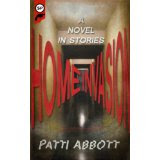(Ed Gorman- from the archives)
In The Yellow Dog, a particularly well-plotted crime novel, Maigret
travels to the small coastal town of Concarneau where a local wine
merchant has been murdered under mysterious circumstances. According to a
witness the man was strolling home on a windy night and paused to walk
up steps leading to the narrow sheltered porch of a long empty house.
Moments later the man fell backwards, dead from the shots.
Once there, Maigret meets the four men and one waitress who seem to know
much more than they're willing to share with him. He also sees a large
yellow dog that keeps appearing at the crime scenes to come. Maigret
feels a kinship with the animal which is more than he can say for
anybody he meets in the town.
Where did the dog come from? Why does he keep showing up at such odd
moments? Does he belong to the person who by book's end kills more
people?
This is a serial killer novel. Simenon even casts the local newspaper editor as
one of the villains. The editor has a history of exploiting bad news to
the point of making each local tragedy worse. And the killings are no
exception. Simenon suggests that it is sop for Frenchmen to a) have
mistresses and b) go about armed. Both are factors in the
investigation.
Most of the elements of classic Maigret are here. The weather is as
vivid as the characters; Simenon buttresses his sociological look at
French life with bleak humor; and his pity for decent people life has
treated badly borders on the religious along with his contempt for
pomposity and self-importance and cruelty.
There is always a claustrophobic feel to the Maigrets; this allows the
reader to experience what the Inspector himself does. As a forlorn
chronicler of humankind Simenon is still without peer.















6 comments:
https://socialistjazz.blogspot.com/2015/11/vincent-price-dramatic-readings-audio.html for some suitable (and unsuitable) for the season Vincent Price recordings.
Thanks for the post of Ed's review. Was reminded of some of his collaborations with/ghost work for Dean Koontz the other day. One doubts they'll be the best-remembered of his work, or Bill Crider's his WISHBONE novels, but I wouldn't be at all surprised if they remain, at the moment, their most widely-read. Sic transit.
It's always worth mentioning a Maigret! Thanks for the reminder, Patti.
Remarkably, my grade eleven French class was assigned Le Chien jaune. This was in suburban Montreal back in the late 'seventies. It was the only time in twelve years of public school that I read a novel in its original French.
Hey, Brian. I doubt that I ever read a novel in either French or Spanish, both of which I took in hs and college. But we did have to listen to a Spanish radio station every day. And watch a Spanish soap opera.
This is a Simenon I have never read but it looks worth hunting down.
I was thrilled I could butcher my way through some of Italo Calvino's IL CASTELLO DEI DESTINI INCROCIATI (THE CASTLE OF CROSSED DESTINIES) while studying Spanish in HS and a bit of conversational Italian on my own, with the translation at hand to help solve the mysteries of each vignette in turn...Hispanophone dialog works better for me these days if I can read accurate captioning in Spanish.
Post a Comment